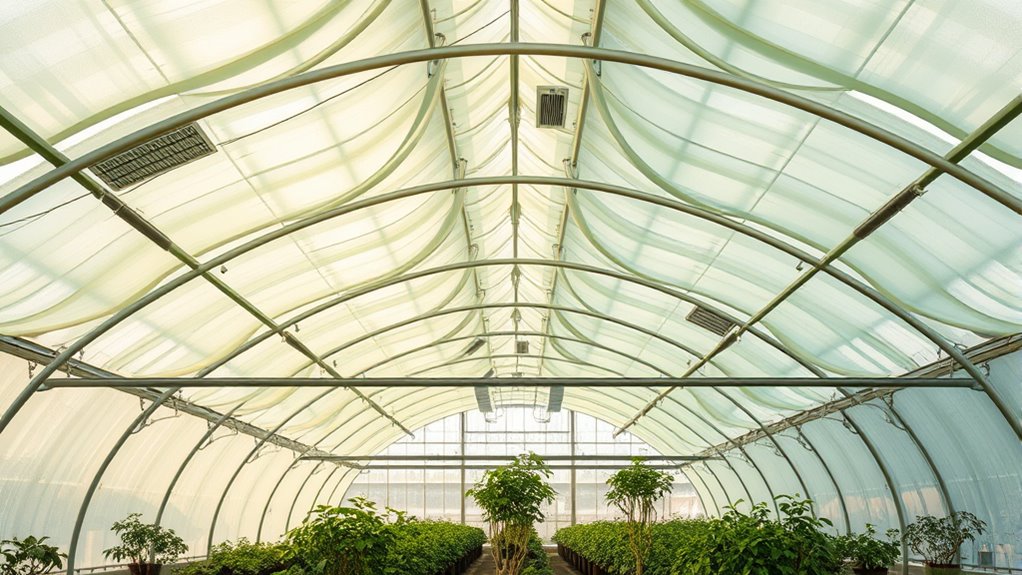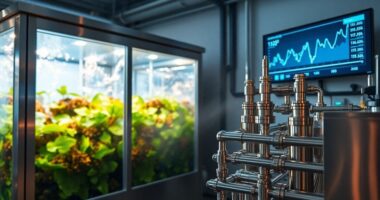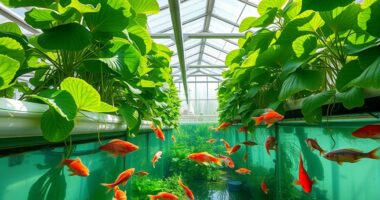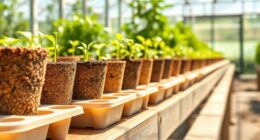To select low-impact greenhouse coverings, focus on sustainable materials like recycled polycarbonate or coated glass that are durable and eco-friendly. Look for options that enhance insulation, reflect infrared radiation, and resist UV damage to maximize energy efficiency. Choose lightweight, easy-to-maintain materials that reduce environmental impact during installation and use. By prioritizing these features, you’ll support eco-conscious farming and optimize your greenhouse’s performance—discover more ways to make your setup even greener.
Key Takeaways
- Choose coverings made from recycled, biodegradable, or renewable materials to minimize environmental impact.
- Opt for durable, long-lasting materials to reduce waste and frequent replacements.
- Select high light transmission, energy-efficient panels with insulating properties to reduce heating and cooling needs.
- Incorporate UV-resistant and reflective coatings to enhance lifespan and thermal regulation.
- Prioritize lightweight, easy-to-install materials that require less maintenance and energy for upkeep.

Choosing the right greenhouse coverings is essential for minimizing environmental impact while maximizing plant growth. When selecting materials, you want options that are sustainable and promote energy efficiency. Using sustainable materials means opting for coverings made from recycled, biodegradable, or renewable resources, which reduces your carbon footprint and minimizes waste. These materials often have a lower environmental impact during their production and disposal, helping you align your greenhouse operation with eco-friendly principles. For example, polycarbonate panels made from recycled plastics or specially coated glass can serve as durable, sustainable options. They not only last longer but also help reduce the need for frequent replacements, further decreasing environmental strain.
Opt for sustainable, durable greenhouse coverings like recycled polycarbonate or coated glass to reduce waste and environmental impact.
Energy efficiency plays a pivotal role in greenhouse management. Coverings that enhance insulation help maintain consistent temperatures, reducing the need for artificial heating or cooling. When your greenhouse retains heat effectively, you cut down on energy consumption, which benefits both your operational costs and the environment. Look for materials with high light transmission to maximize natural sunlight, which promotes healthy plant growth without increasing energy use. Double or triple-layer coverings, such as insulated polycarbonate or multi-wall panels, can notably improve thermal retention. These options trap heat during colder months and prevent excessive heat gain during warmer periods, making your greenhouse more energy-efficient year-round.
Incorporating sustainable materials that boost energy efficiency doesn’t mean sacrificing durability or plant health. Many modern coverings are designed with advanced coatings that reflect infrared radiation, helping to keep the interior cooler in summer while trapping heat in winter. This dual benefit minimizes reliance on energy-consuming climate control systems. Additionally, some coverings incorporate UV-resistant layers to prolong lifespan and maintain clarity over time, reducing the need for frequent replacements. When choosing your materials, consider how well they insulate and how much light they transmit, ensuring optimal conditions for your crops with minimal energy input. Selecting energy-efficient coverings can further enhance your greenhouse’s overall sustainability and operational effectiveness.
Your choice of greenhouse coverings should also factor in ease of installation and maintenance. Sustainable, energy-efficient materials are often lightweight and simple to install, saving you labor and time. They also require less maintenance, which lessens the use of cleaning agents or replacements that could harm the environment. By opting for these eco-friendly options, you create a more sustainable, energy-smart environment that supports healthy plant growth while reducing your ecological footprint. Ultimately, selecting coverings that prioritize sustainability and energy efficiency enhances your greenhouse’s productivity and aligns with responsible environmental stewardship.
Frequently Asked Questions
How Do Low-Impact Coverings Affect Plant Growth Rates?
Low-impact coverings can positively influence your plant growth rates by optimizing light transmission and thermal insulation. They allow enough sunlight to reach your plants, promoting photosynthesis, while also maintaining a stable temperature by reducing heat loss. This creates a better growing environment, helping your plants grow faster and healthier. By choosing the right low-impact covering, you guarantee your plants get sufficient light and warmth without harming the environment.
Are Low-Impact Coverings Suitable for All Climate Zones?
You’ll find low-impact coverings suit many climate zones, offering sustainability benefits and enhancing material durability. Imagine your greenhouse bathed in gentle sunlight, protected yet eco-friendly, adapting seamlessly whether in warm or cooler areas. These coverings help conserve energy and reduce environmental impact, making them versatile for various climates. With proper selection, you guarantee your plants thrive while supporting sustainable practices, creating a resilient, eco-conscious growing environment.
What Is the Lifespan of Eco-Friendly Greenhouse Coverings?
Eco-friendly greenhouse coverings typically last between 3 to 7 years, depending on the material durability. You’ll find that the cost comparison favors sustainable options over time, as their longevity reduces replacement needs. While initial costs might be higher, investing in durable, eco-friendly materials guarantees you get the most out of your covering, minimizing environmental impact and maintenance. Proper care can extend lifespan, making them a smart, eco-conscious choice for your greenhouse.
How Do These Coverings Impact Greenhouse Ventilation?
Think of your greenhouse coverings as a delicate dance partner. They can enhance or hinder ventilation efficiency depending on their material. When you choose low-impact coverings, you often improve airflow regulation, allowing fresh air to circulate more smoothly. This helps prevent overheating and humidity buildup. You’ll find that these eco-friendly options, with proper installation, support natural ventilation, making your greenhouse a healthier, more balanced environment for your plants to thrive.
Can Low-Impact Coverings Be DIY Installed?
Yes, you can DIY install low-impact greenhouse coverings. They’re often designed for easy, cost-effective options, making them suitable for DIY projects. With some basic tools and careful planning, you can save money and guarantee proper fit. Just follow manufacturer instructions closely, and consider seeking advice from online forums or guides for best results. DIY installation not only reduces costs but also gives you more control over your greenhouse setup.
Conclusion
As you choose your greenhouse coverings, imagine the gentle whisper of sunlight filtering through eco-friendly materials, casting a warm glow on thriving plants. Picture the subtle dance of shadows and light, nurturing your crops without leaving a heavy footprint on the earth. By selecting low-impact coverings, you create a sanctuary that harmonizes with nature’s rhythm, ensuring a lush, sustainable future. Your mindful choice becomes a quiet act of stewardship, shaping a greener, more vibrant world inside and out.








